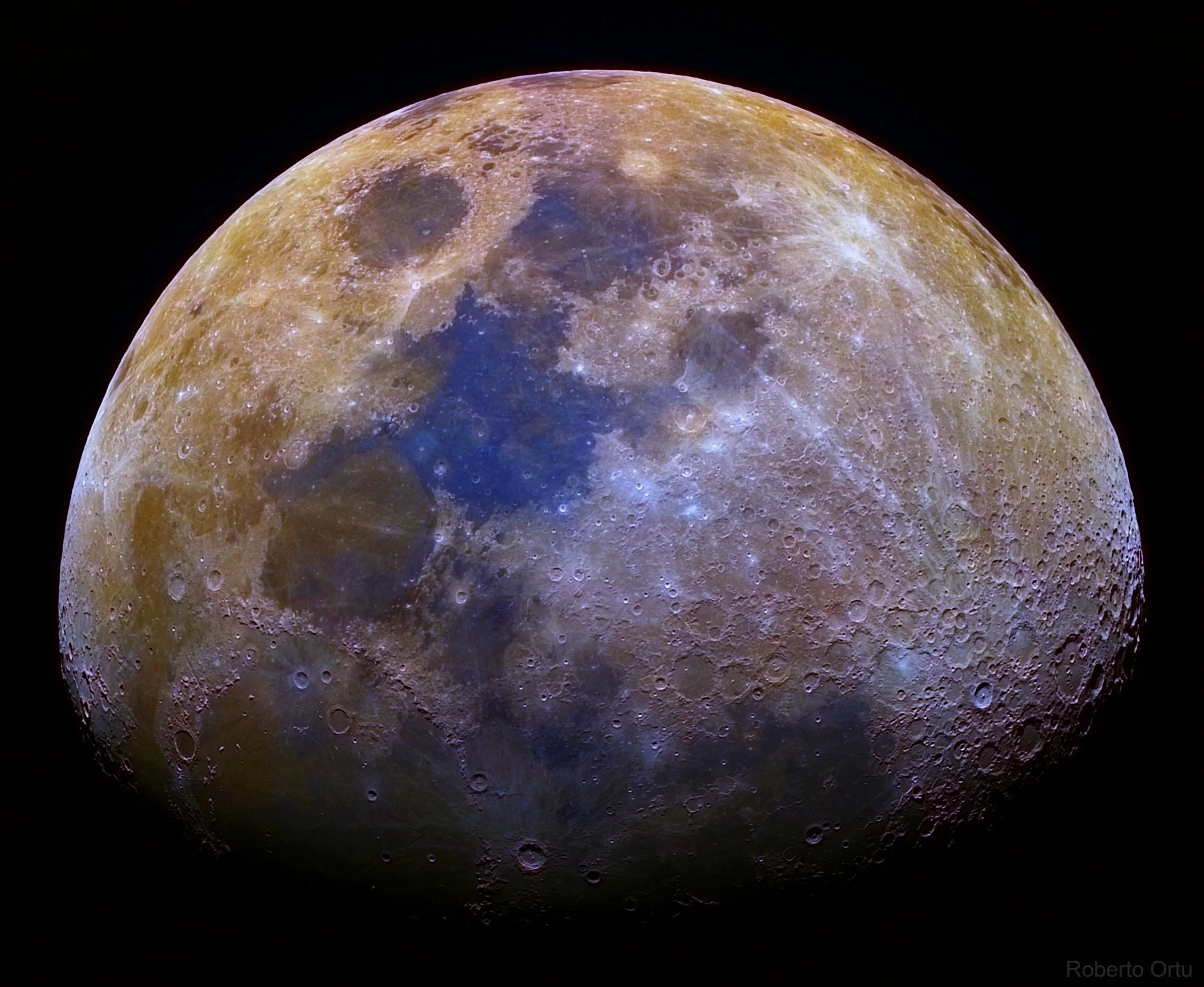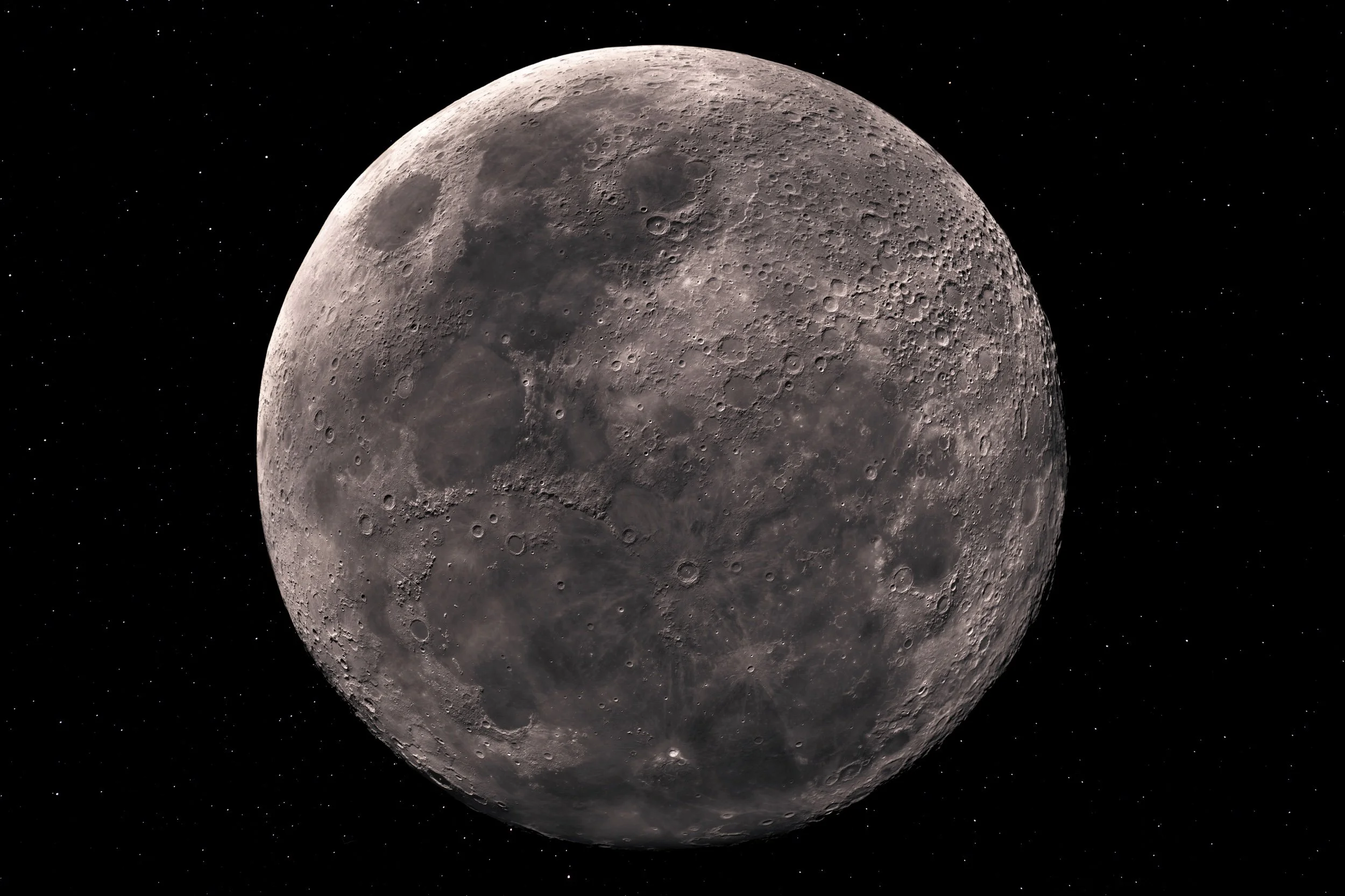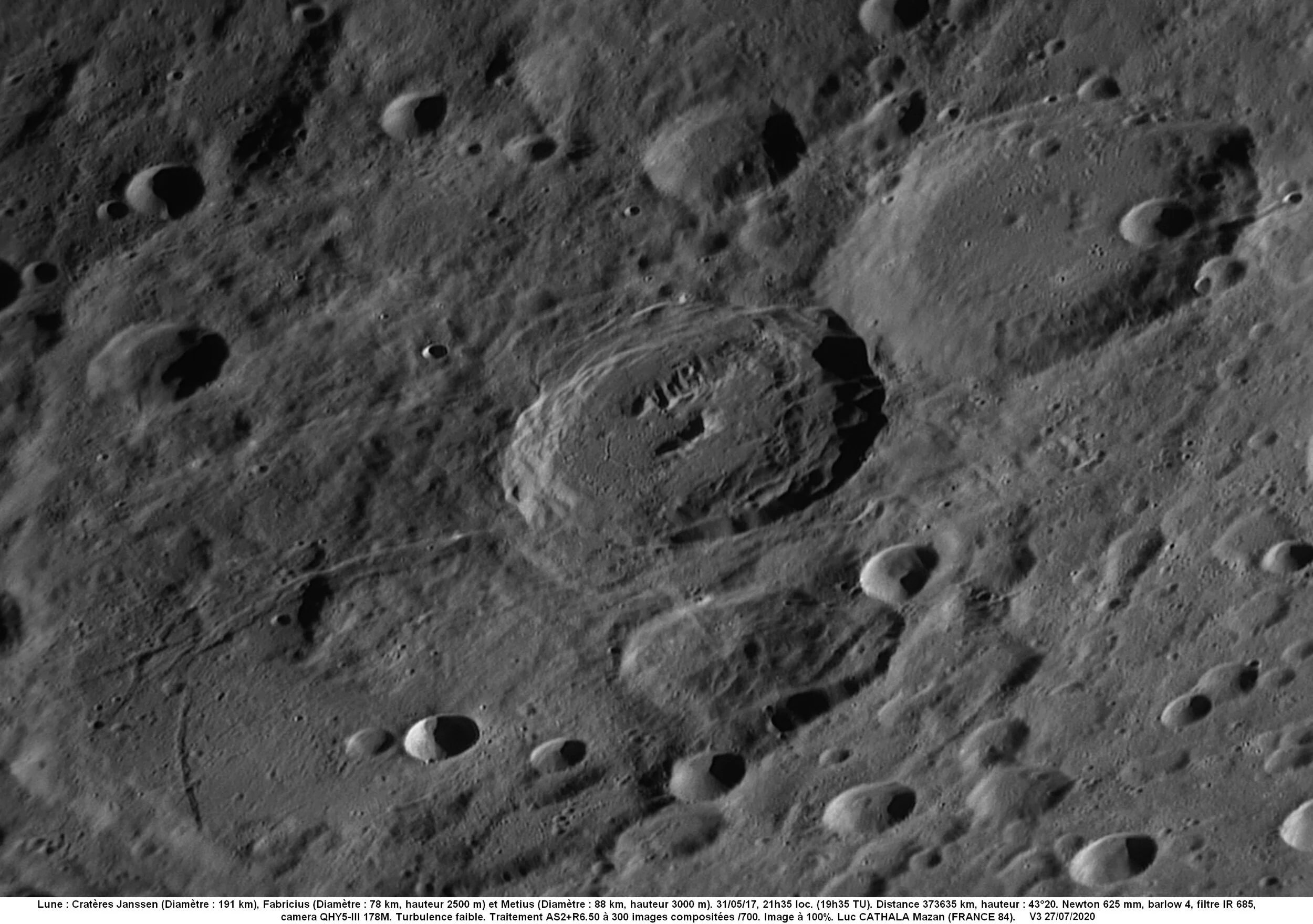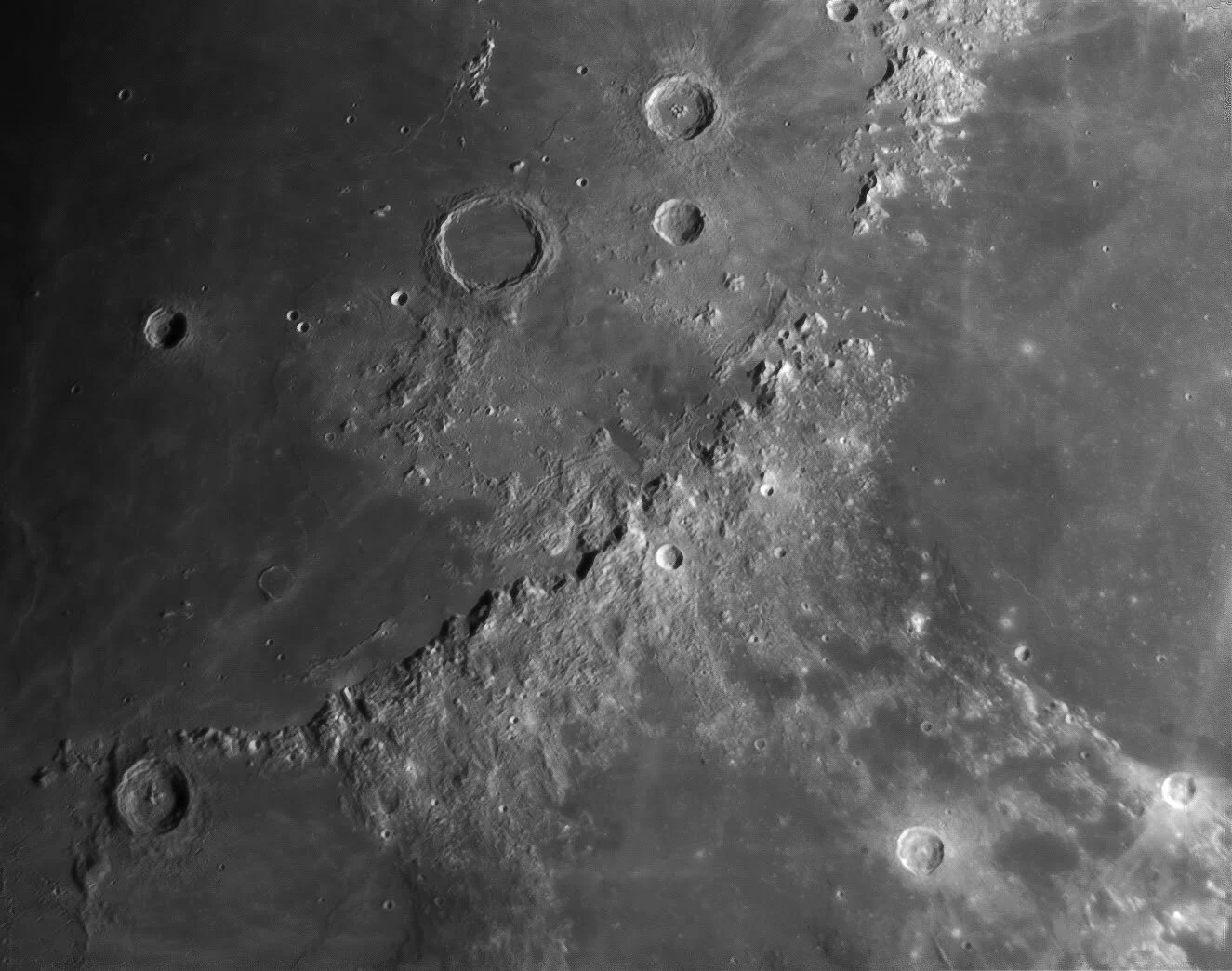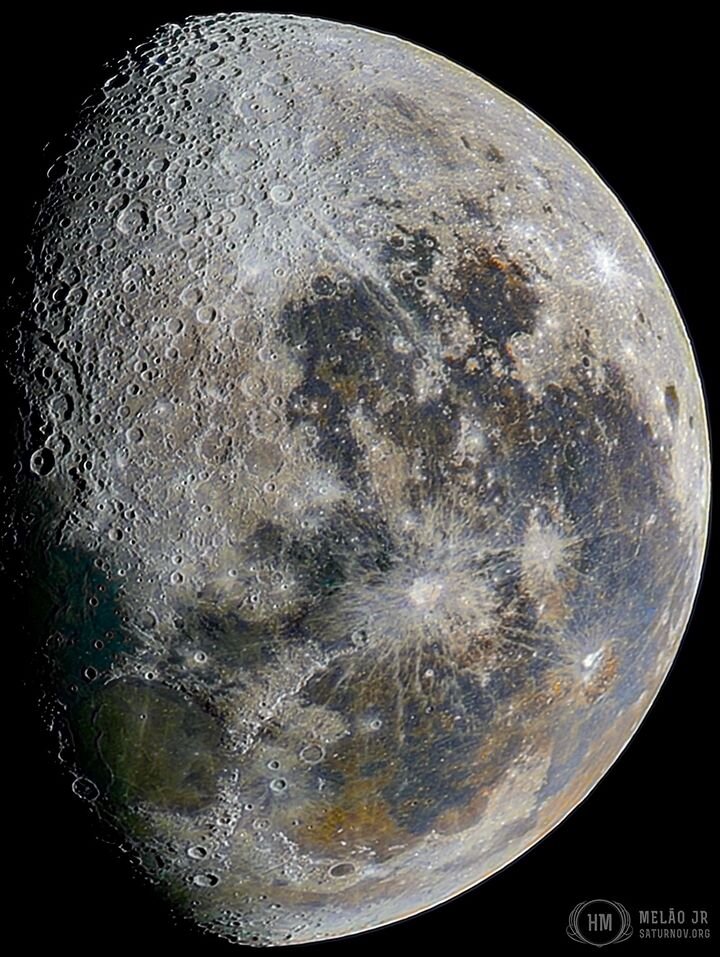
AAPOD2 Image Archives
Shadows and Peaks Along Alpine Valley
This high-resolution lunar image showcases the dramatic contrast between shadowed and sunlit terrain along the terminator, revealing an intricate interplay of impact history and geological evolution. The dominant crater Aristoteles, a 3.8-billion-year-old impact structure, stands out with its terraced walls and central peak, while the neighboring Eudoxus adds to the rugged topography. Below, the Cassini crater, partially flooded by ancient lava, marks the transitional boundary between the rough highlands and the smooth plains of Mare Imbrium. The rugged Lunar Alps stretch across the frame, with the sinuous Alpine Valley cutting through them—a rift possibly formed by tectonic forces or subsurface magma movement. This image is a striking testament to the Moon’s violent past and the forces shaping its ever-scarred surface.
Lunar Northern Hemisphere
The northern hemisphere of the Moon is often referred to as the "Lunar Northern Highlands" or simply the "Lunar North." This region is characterized by rugged terrains, highlands, and numerous impact craters. Some notable features within the lunar northern hemisphere include the expansive plains of Mare Frigoris, the prominent craters Plato and Archimedes, and the rugged terrain of the Montes Caucasus and the Montes Alpes mountain ranges. The lunar north provides a diverse and visually compelling landscape for lunar observers and researchers alike.
A colorful Moon mosaic
Image Description and Details : This is my lunar mosaic of the waxing gibbous mineral Moon (9.50 days old).
Technical data:
Celestron 114/910 Newton
Planetary camera QHY5L-II-C
Filter UV IR cut
Software: Sharpcap 3.2, Autostakkert! 3.1.4, Astrosurface T5-TITANIA, Autostitch, GIMP
Location: Cabras, Sardinia, Italy
Copyright: Copyright: Roberto Ortu
Is this close enough for you?
Image Description and Details : This ultra high resolution of the full moon was constructed using a total of 1530 individual photos captured during all consecutive phases of the moon from new moon to full. The resulting single image measures a whopping 165,000 megapixels, (50,000 x 33.000 pixels).
The assembly of the final images took over 300 hours to stitch together to piece together this one single image.
Imaged from Perth, Western Australia using ...
Skywatcher 12@ Dobsonian Goto Telescope
2x Barlow lens
ZWOasi 183mc Camera
A video presentation with description of several major craters can be found on the above link.
Copyright:: David Gray
Full Moons of 2021
Image Description and Details :
I was very lucky to be able to capture all the full moons of 2021. The image represents 12 full moons of 2021 with their popular names, distance from Earth and angular diameter. The centre piece is a mosaic made with strips from all the 12 full moons.All the images were captured with the same camera (Nikon D5600) and lens (Sigma 150-600c) at a same focal length (600mm). The individual moons are a stack of 300 images each.
Copyright: Soumyadeep Mukherjee
Ghost Crater (Astroavani/Brazil-2012)
Image Description and Details : With only 2 months left to complete 10 years of the ghost crater discovered by me, I present a new photo in better resulution of the formation in question and take the opportunity to transcribe the original text with some minor adaptations."I've always had the greatest interest in astrophotography of Lunar formations and from the beginning, using mainly the Virtual Moon Atlas, I tried to find and know the most striking features of the regions I observed or photographed.As time went by, I acquired a better knowledge and more easily recognized these regions and their main accidents, which greatly facilitated the perception of anything that clashed with the traditionally observed landscape.So on January 5, 2012, photographing the region near Plateau Aristarchus, I noticed a strange depression that caught my attention. I tried to locate it on lunar maps and even in the Virtual Moon Atlas, but I found nothing.I searched the internet, asked for help from colleagues in Brazil and abroad to clarify what this training could be, I believed that it should already be known or that others had already observed it.In principle, I couldn't find any reference to this lunar formation.Looking at the attached photo, the impression we have is the existence of a depression that is only revealed when the Sun is at a very low angle of illumination.I sent the original photos to my friend Vaz Tolentino from the Lunar Observatory (VTOL) back in 2012 and he gave me the following explanation: Indeed, your photo, due to the angle of sunlight, captured an interesting and unusual circular depression, which has along its southwestern rim, the crater WOLLASTON D (5km in diameter). The formation is very strange in that it doesn't look in the style of known ghost craters. The strange and unusual thing is that, it appears that the supposed crater was flooded by basaltic lava and, instead of filling up and leveling off with the surrounding outer floor, it only filled a little and didn't even out, remaining like a "gourd" or "bowl ", in addition to leaving no traces of a central peak. This depression appears to be about 42 km in diameter, being slightly larger than ARISTARCHUS. I checked LRO images and unfortunately I can't identify anything due to the sunlight being high in the photos. We need more photos of this region, in light conditions similar to the one in this photo.At Alexandre Amorim's suggestion, I decided to contact BAA (http://www.baalunarsection.org.uk/) Lunar Section where I made contact with Dr. Anthony Cook. I sent to the same the photos obtained by me in January and June 2012, as well as I reported the suspicion that the referred depression had not yet been catalogued. After exchanging several emails, I received the following message from Dr. Cook, which I transfer in full:On Mon 4/06/12 07:06 , "Tony Cook [atc]" atc@aber.ac.uk sat:Dear Avani,Thank you for your images. It looks like a buried ghost crater that you have found. Please keep on looking for another ghost craters elsewhere on the Moon because I think that there may be quite a few that are visible near to sun rise or sunset that remain to be discovered. I think this work will be of great interest to Peter the Greek.
Dr Anthony Cook Institute of Mathematics and Physics, Aberystwyth University, Penglais, Aberystwyth, Ceredigion. SY23 3BZ. United KingdomIn April 2013 using the new QHY 5L camera, a color CMOs dedicated to high resolution Lunar and planetary photography, I got a more detailed photo of the place where the depression was located:This allowed colleague Vaz Tolentino to trace the altimetric profile of depression and perform the following analysis:"Dear Avani and Amorim:Analyzing the Avani photos (January/2012 - April/2013), together with the altimetric profile that presents a classic phantom crater depression, I reach the conclusion that, most likely, it is the discovery of a new phantom crater without cataloging.Also analyzing the altimetry of the ghost craters DAGUERRE, LAMONT and that discovered by VTOL in February 2011, I came to the conclusion that they have very similar altimetric profiles, and the Avani ghost crater is a little shallower (46 km of diameter per 130 m depth) than DAGUERRE and LAMONT (both approximately 400 m deep).However, Avani's ghost crater depth (130m) is more compatible with the ghost crater discovered by VTOL (which is approximately 100m deep). What this means?It means that, in the past (at the time of the ancient selenographers), when the main interest in observing the Moon was to map its relief, identifying and naming its formations, they did not have the current technology, that is, shallow formations like these two Phantom craters (Avani and VTOL) are very difficult to see through an eyepiece, to be sure of what you are actually looking at.After the initial period of cataloging and naming relief formations, lunar map drawings and other studies, the space age arrived. The first robotic lunar probes (Soviet and American) and the manned landings of the APOLLO missions had other scientific goals than discovering new, uncatalogued formations. Furthermore, even in the very high resolution photos taken by modern robotic lunar probes (SELENE, LRO, GRAIL, etc.), the images were mostly captured with sunlight coming from above and not obliquely, which makes it difficult relief enhancement and does not facilitate the identification of shallower formations such as these phantom craters.For modern selenographs, only after the technological evolution of digital cameras (CCD and CMOS), together with the evolution of telescope optics (large and good mirrors and also APO lenses), combined with the favorable angle of incidence of light on the lunar surface, it became easier to identify new smaller formations, "camouflaged" and not cataloged on the Moon.Congratulations Avani Soares on your discovery!Another point marked by the new generation of Brazilian selenographers. A hug from the VTOL team!In this way, I believe that any misunderstanding regarding the existence and identification of the aforementioned training is ruled out, only lacking the official disclosure and recognition to crown the aforementioned work."
Copyright: Astroavani
The Janssen Fabricius and Metius
The Janssen Fabricius and Metius trio caught with low turbulence and my Newton 625mm IR685 barlow Televue 4X and QHY5III 178M . Note the three connected valleys in Fabricius.
Copyright: Luc Cathala
Montes Apeninos
Image Description and Details The Apennines stretch a total length of about 600 km and the mountain peaks reach heights of 5000 m. The slopes towards Mare Imbrium are relatively steep with slopes of approximately 30 °, while on the opposite side, towards Mare Vaporum and Sinus Aestuum they are significantly less.
Equipo:
Telescopio CPC1100
Cámara Zwo Asi 385mc
Observatorio CASA
Granada / España
Copyright: Benjamin Hernandez
Battle of the Moons
Image Description and Details :
The image displays the angular size difference between a "super" moon and a "micro" moon. The micro moon is the Cold Moon of 2020 (captured on 30th December 2020) and the super moon is the Pink Moon of 2021 (captured on 27th April 2021). The super moon gets almost 10% bigger in the night sky due to its closer approach to Earth.Gear: Nikon D5600, Sigma 150-600cPost-processing: PIPP, Autostakkert, Adobe Camera Raw, PhotoshopCapture Date: 30th December 2020 and 27th April 2021Location: Kolkata, India
Copyright: Soumyadeep Mukherjee
Sinus Iridum to Plato
Image Description and Details :
Sinus Imbrium to PlatoSinus Iridum (“Bay of Rainbows”) to crater Plato on the northwestern rim of Mare Imbrium. Out in the lava sea, Montes Recti (“Straight Range”) points toward Montes Teneriffe just below Plato (“Tenerife Mountains”, as in the Canary Islands. These isolated mountains form part of an inner impact uplift rim of Imbrium, gouged by an asteroid estimated at 236 km across.Santel MK-91 230 mm f/13 Maksutov-Cassegrain (FL 3,000 mm) on an AP 900 mount, from January 25, 2021. Camera: FLIR Grasshopper 2 GigE; Best 1,600 of 13,200 frames at 22 FPS, from Ossipee, New Hampshire.
Copyright: Robert Gillette
Moon Montes Apeninnus and Eratosthenes crater
Image Description and Details :
Registration on Feb. 20 of a set of interesting formations on the edge of the Mare Imbrium, starting with the Eratothenes crater (diam. 58 km, depth 3600 meters), where the mountain range of the Apeninnus Mountains begins, extending for 953 km formed by the rubble the great impact that created the Mare Imbrium. Apeninnus is home to some of the highest peaks on the visible face of the Moon, including Mons Huygens which according to the most recent and accurate assessments reaches 4950 meters.In the upper part of the image, it is also possible to observe a ghost crater Wallace, remnant of a crater formed in the Imbrian period (3.8 ~ 3.2 a.a.) that was filled by lava and formed edges located 400 meters above the surface.In the box, a perspective view (generated through QuickMap) of Mons Huygens.Tele GSO 305 mm @ f / 12, ASI290MM camera
Copyright: Conrado Serodio
Pythagoras Crater
Pythagoras Crater is at the center of this field of view and is a prominent impact crater located near the northwestern limb of the Moon. It has a diameter of 80 miles and is 16,400 feet deep. The prominent central peak rises just over 4,200 feet and is casting a very long shadow that appears to just be touching the western wall of the crater. The rim is well-preserved and the terraced walls are quite apparent. Captured Jan 26 during a full terminator imaging session at 20:28 during the 97.3 % waxing phase. To the southeast is Babbage and to the northeast is Anaximander.Celestron CPC Deluxe 1100 HDAltair IMX174 MonoZWO Filter Wheel - Green Channel FilterX-Cel 3.0 BarlowPrimalucelab Eagle 2 Pro
Copyright: Gary Varney
Lunar craters: Endymion & Hayn
Many interesting the crater Hayn located to the northeast limb of the Moon. The observation of the crater is affected by the libration phase and this limits its view.
C14 Edge HD, Fornax52 mount, ASI174 mono, Baader R+IR>610nn Barlow Zeiss.
https://www.astrobin.com/full/ue0hip/0/?nc=user
Agerola-Amalfitan-Coast-Italy
Copyright: Morrone Luigi
Mineral Moon
Image Description and Details : Sky-Watcher 200/1000HEQ5 Pro SynScanCanon EOS 450DISO 1001/1000Stacked 31 photo
Copyright Information: Alessandro Biasia
Colors of the Moon
Image Description and Details :
Celestron 102 GT
Sony A7R II
Teleconverter Kenko 3x
40 frames ISO 50, 1/40s,
Copyright: Hindemburg Melao Jr
Clavius and Moretus
Imaging telescope or lens: Celestron C14 EDGE HD
Mount:CGE Pro
Software: Fire Capture, AS!2, Photofiltre - Irfan
Filtro: Baader Planetariun IR Pass 685
Copyright: Avani Soares




